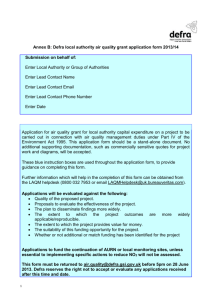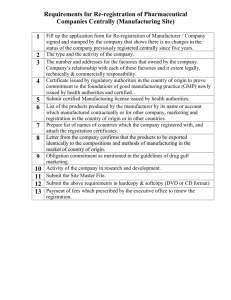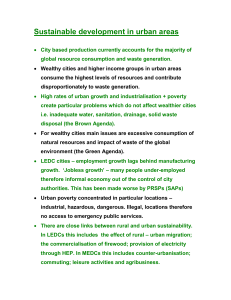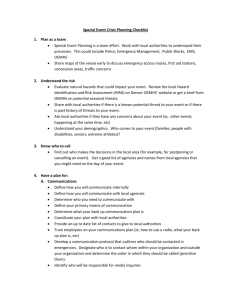here - Eastleigh Borough Council
advertisement
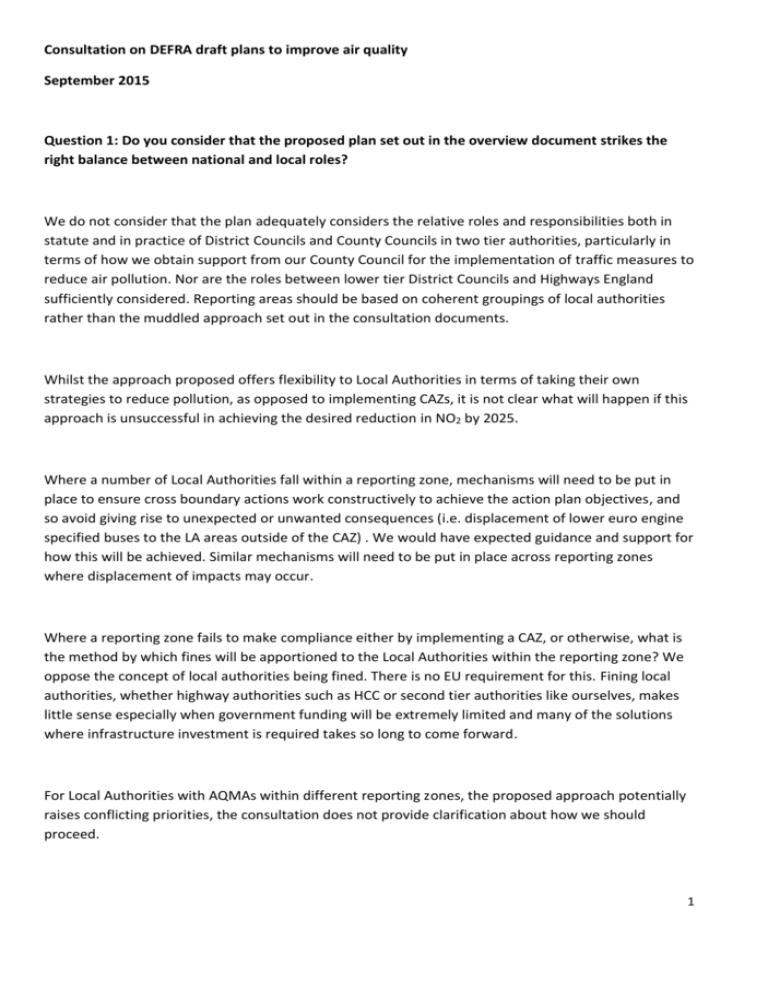
Consultation on DEFRA draft plans to improve air quality September 2015 Question 1: Do you consider that the proposed plan set out in the overview document strikes the right balance between national and local roles? We do not consider that the plan adequately considers the relative roles and responsibilities both in statute and in practice of District Councils and County Councils in two tier authorities, particularly in terms of how we obtain support from our County Council for the implementation of traffic measures to reduce air pollution. Nor are the roles between lower tier District Councils and Highways England sufficiently considered. Reporting areas should be based on coherent groupings of local authorities rather than the muddled approach set out in the consultation documents. Whilst the approach proposed offers flexibility to Local Authorities in terms of taking their own strategies to reduce pollution, as opposed to implementing CAZs, it is not clear what will happen if this approach is unsuccessful in achieving the desired reduction in NO2 by 2025. Where a number of Local Authorities fall within a reporting zone, mechanisms will need to be put in place to ensure cross boundary actions work constructively to achieve the action plan objectives, and so avoid giving rise to unexpected or unwanted consequences (i.e. displacement of lower euro engine specified buses to the LA areas outside of the CAZ) . We would have expected guidance and support for how this will be achieved. Similar mechanisms will need to be put in place across reporting zones where displacement of impacts may occur. Where a reporting zone fails to make compliance either by implementing a CAZ, or otherwise, what is the method by which fines will be apportioned to the Local Authorities within the reporting zone? We oppose the concept of local authorities being fined. There is no EU requirement for this. Fining local authorities, whether highway authorities such as HCC or second tier authorities like ourselves, makes little sense especially when government funding will be extremely limited and many of the solutions where infrastructure investment is required takes so long to come forward. For Local Authorities with AQMAs within different reporting zones, the proposed approach potentially raises conflicting priorities, the consultation does not provide clarification about how we should proceed. 1 Consultation on DEFRA draft plans to improve air quality September 2015 The Action Plan areas need to be more focussed on the travel to work areas or other criteria which makes sense in terms of cause/effect, monitoring and construction of action plans and measuring their outcomes. The current grant funding schemes are complicated and even when approved, are difficult to implement in practice. Business partners advise that schemes with longer implementation periods, say 3 to 5 years, would provide greater opportunities for business planning and investment decisions to be taken. The current approach is an impediment to timely action. Grant funding scheme application and implementation processes should be streamlined to improve the process and encourage applications and speed up implementation of measures. Question 2: Are you aware of any other action happening in your area which will improve air quality and should be included in the plan? If yes, please identify as far as you are able: a. What the additional actions are; b. The zone(s) in which they are being taken; and c. What the impact of those actions might be (quantified impacts would be particularly useful). The reporting zone Action Plans do not appear to take account of decisions taken by upper tier Local Authorities such as County Highways authorities or County Minerals and Waste planning authorities which could give rise to increased levels of air pollution through new roads, highways changes or permissions for waste incineration / biomass facilities. Similarly, the approach does not clarify how highways changes brought about by Highways England will ensure future and ongoing compliance. Question 3: Within the zone plans there are a number of measures where we are unable to quantify the impact. They are included in the tables of measures. Do you have any evidence for the impact of these types of measures? No. This is unlikely without detailed analysis being carried out at local level, financial support / additional resource to carry out these analyses from Defra would expedite this. 2 Consultation on DEFRA draft plans to improve air quality September 2015 We are concerned that the modelling of current, 2013, and future air pollution levels is not robust. Comparing ‘modelled’ current levels for 2013 with our actual monitoring data shows locations where we currently exceed the annual limit level, however these locations are shown as complying with the limit level in the consultation report. There appears to be no process by which these ‘real world’ data can be incorporated into the modelling carried out by Defra, nor a way forward for how we deal with these inconsistencies. Question 4: Do you agree that a consistent framework for Clean Air Zones, outlined in section 4.3.6 of the UK overview document, is necessary? If so, do you think the criteria set out are appropriate? To meet Defra’s objectives of encouraging innovation to achieve our goals it would be beneficial if LAs were given a freer hand to implement strategies to achieve the objectives. The current CAZs are too prescriptive, it would be beneficial if there was an option for graduated approaches, or for voluntary schemes, as with LESs. The mandatory approach risks alienating those groups that have done the most to reduce emissions and creating a negative impressions in the minds of the general (motoring) public. Until such time that we know that mandatory measures are necessary within clearly defined areas, LAs should be given the freedom to innovate, subject to suitable agreed progress goals and timescales. As highlighted above the reporting zones cover several LAs with little to guide how we work together. For example alterations and changes to traffic routes could displace pollution from one LA area within a reporting zone to another. To lessen the potential for this, regional approaches should be considered to ensure required actions which extend, or could impact across, LA boundaries take proper account of these impacts. This approach should also be applied to include relevant highways authorities. Question 5: What do you consider to be the barriers that need to be overcome for local authorities to take up the measures set out in section 4 of the UK overview document? How might these be overcome? Are there alternative measures which avoid these barriers? External bid funding streams (eg Local Sustainable Transport Fund) are time-limited and in the case of LSTF have not been replaced after that money ran out in 2015. The feast or famine nature of funding, 3 Consultation on DEFRA draft plans to improve air quality September 2015 together with changing criteria for bid projects to meet, means that constructing a long term strategy is very difficult. A simpler approach to providing funding streams to support measures to reduce emissions would be beneficial, the current approach has too many streams risking making the approach confused. Simplified procedures and longer implementation periods for successful bid projects would assist with business planning for all parties and particularly our commercial partners. Greater flexibility should be given to LAs when making use of awarded funds. Clarify and enhance current national planning policy and practice guidance to highlight the importance of strategic land use allocations, infrastructure planning schemes and of planning application decisions, taking account of air pollution issues. The current process does not adequately consider ‘cumulative’ impacts arising from multiple planning applications which have the potential to act detrimentally on air pollution. The impact of development plans on air quality needs to be assessed more thoroughly. The present presumption in favour of sustainable development within the NPPF. This approach does not allow for schemes to adequately consider air pollution at the decision making stage. Air quality needs a higher profile as part of sustainable development as defined in the NPPF. Greater funding to encourage uptake of cycling, provision of safe cycling routes, modal shift and uptake of electric and hybrid vehicles. Overall levels of funding are insufficient to make a real, rapid difference and barriers such as match funding requirements are making it hard for smaller authorities to efficiently bid for funding. 4 Consultation on DEFRA draft plans to improve air quality September 2015 Question 6: Are you aware of any additional action on non-transport sources to improve air quality that should be included in the plans? The existing regulatory approach does not give powers to LAs responsible for implementing LAQM to ensure that they have the information they need to take account of all the actions of others. For example actions by Mineral and Waste Planning authorities, or Highways authorities as this is dependent on good will and it is not prescribed that these other bodies notify LAs. Similarly private businesses falling outside of other regulatory systems, e.g. LAPPC / LA-IPPC, or other large contributors such as ports. 5 Consultation on DEFRA draft plans to improve air quality September 2015 6



